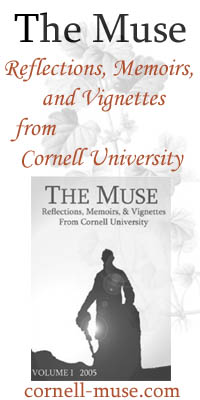Cornell Alumnus Takes (and Writes) to the Mountains
In keeping with our springtime series of young Cornell author interviews, we're pleased to offer the following discussion with Peter Bronski '01, who recently published At the Mercy of the Mountains: True Stories of Survival and Tragedy in New York's Adirondacks.
Cornell's rugged, stunning campus on Ithaca's East Hill has always drawn students who love the outdoors, and Bronski is no exception. He studied natural resources at Cornell before going in be part of the Lower Adirondack Search and Rescue team, and was formerly the manager for Audubon International's Sustainable Communities Program, before becoming a full-time writer.
For those in the Ithaca area, Peter will actually be doing a book signing and a Q&A at the Ithaca Barnes and Noble, Thursday, June 12, at 7:00 PM.

You recently published your first book – At the Mercy of the Mountains – a book that presents vivid, life and death accounts of adventurers in the Adirondack region of New York State. How did you get the idea to write about this book?
The Adirondacks are familiar territory for me. For a number of years I lived near the southern gateway to the Adirondack Park. During that time, the Dacks were my playground for outdoor adventure – rock climbing, ice climbing, skiing, backpacking and camping. I also became a member of the Adirondack Mountain Club, as well as a member of a volunteer search and rescue team, Lower Adirondack Search and Rescue. That combination of experiences was the foundation and inspiration for the book.
In your research, were there any surprising themes that you found recurring in these stories? Is there anything that the casual weekend warrior might want to keep in mind?
In so many cases, the crux of the misadventures – and whether they turn out positive or negative – comes down to human error. The decisions that people make in the backcountry are often the turning points in a story – to continue upward in the face of a storm, to overlook the conditions in the high country, to leave behind a crucial piece of equipment, to explore a too-steep rock face without ropes. Our response to scenarios, more than anything else, determines their outcome.
What do you think motivates otherwise rational people to put themselves in such risky situations? Skiing a fresh snow pack on an open slide, for example, when there have been avalanche warnings issued?
By and large, I don’t believe that people are intentionally or knowingly putting themselves into inherently risky situations. It’s also worth noting that infinitely more people enjoy the Adirondack mountains without incident, than those who wind up getting into trouble. That being said, the risk takes on new and bigger proportions not in any one single act, but in the sequence many small increments. For that reason, I think we don’t see the gradual shift where we cross a threshold into life-threatening situation, versus just a little more risk than we had before.
As far as the backcountry skiers were concerned with the avalanche, it’s easy to analyze their sitution out of context. Yes, there was fresh snow. Yes, the slide was measured at 37 degrees, a prime angle for avalanche. But no explicit avalanche warnings were issued for the Adirondacks, and historically, the Adirondack snowpack has shown itself to be very stable, especially when compared to the continental snowpack of a place like Colorado. Avalanches have not been a major part of the collective Adirondack experience. But as that incident demonstrated, they can and do happen. Surely, the backcountry community will treat the Adirondack snowpack with a new attitude of caution and respect.
And what’s the most life threatening situation you have ever found yourself in?
In the prologue of the book, I describe one of my misadventures during a solo backcountry ski ascent and descent of Mount Marcy. But the most legitimately life-threatening situations have happened elsewhere – in Colorado and the Swiss Alps – where I had close calls with rockfall and lightning strikes.
At Cornell, you were heavily involved in Cornell Outdoor Education, teaching climbing and mountaineering courses, and participated in two major expeditions, one to Mexico and the other to Ecuador. Did Cornell help to shape your interest in these activities, or did you arrive in Ithaca with an affinity for the outdoors?
I definitely arrived in Ithaca with a love of the outdoors. As a child I grew up camping and hiking in the Catskills and in Maine during summer family vacations. When I was older, in high school, I started rock climbing at an indoor gym. I had also been an armchair mountaineer for years, reading books about different expeditions. But it was COE that finally gave me an outlet to further develop my skills, and to travel to new places to climb.
As a Cornell climber, what was your favorite building on campus to climb on?
There was a wall behind Helen Newman Hall on North Campus, above Beebe Lake, that we would builder on until our fingertips were sore. That was definitely my favorite spot.
And so, naturally, you wouldn’t happen to know the culprits of the McGraw Tower pumpkin prank?
I was on campus during that whole incident, but have no idea who pulled it off.
More seriously, were you interested in writing in college, or did it develop after you graduated?
During my last semester at Cornell, I took a seminar in “non-fiction writing for magazines.” That course was a catalyst. It opened my eyes to the prospect of writing. Several months after graduation, I published my first magazine article, and I’ve been working hard at it since.
Would you have any advice to aspiring Cornellians looking to follow in your footsteps – either from an outdoor adventuring or writing standpoint?
Don’t be afraid to whole heartedly embrace your passion. If you are passionate about something, you can make it happen. It takes skill for sure, but more than anything else, it takes tenacity.
Tell us a bit more about your two other books that will be released later this year.
Power Ghost Towns: Epic Backcountry Turns at Colorado’s Lost Resorts will come out in October 2008 from Wilderness Press. It’s one part history book, and one part backcountry skiing guidebook. I researched and visited 36 lost ski areas – ski resorts that once operated on the slopes of Colorado’s Rockies, but that have long since shut down. The book chronicles their history, and also describes how to find and ski them as a backcountry skier.
Hunting Nature’s Fury: A Storm Chaser’s Obsession with Tornadoes, Hurricanes and Other Natural Disasters will come out in March 2009 from The Lyons Press. On this project I worked with a co-author, Roger Hill. Roger is one of the most talented and accomplished storm chasers alive. We collaborated to tell the story of storm chasing on the Great Plains, drawing largely from Roger’s experiences and life history.
You went to school and spent a fair amount of time out East, but are now living in Colorado. Are the Adirondacks and White Mountains just not high enough for you?
It’s not a matter of altitude. My wife, Kelli, and I were living in the New York City area, and we found ourselves often driving five hours one-way on the weekends to go the Adirondacks or the Whites. We wanted to live in a place where our outdoor pursuits were closer at hand. Colorado offered us the right mix of work-life balance, landscape, job opportunities, etc.
And last but not least, what was your favorite hike in the Ithaca area? Your favorite hike in the Adirondacks?
Any of the gorges are high on my list – Cascadilla, Fall Creek, Robert H. Treman, Taughannock, Buttermilk. Owl Gorge in Buttermilk State Park is a great off-trail gorge I “discovered” while doing salamander research for a Natural Resources class. I also love the loop around Beebe Lake.
In the Adirondacks, the route up to and through Avalanche Pass is spectacular. You’re surrounded by the High Peaks, and the way the cliffs close in around the lake is awe-inspiring.



